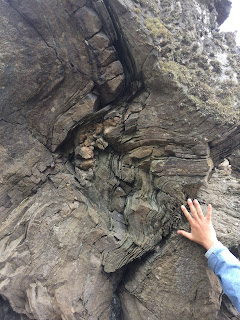North-West Highlands a landscape aesthetically carved by geology

North west highland is located at one of the ancient coast close to the Atlantic and Loch Gleann dubh. Before we dive into the great geologic history that this place offers, I would like to talk about couple things that happened at the time.Our day started as we checked out of Portress hostel, we neatly packed our belonging into our vans and drove for more than 3 hours to Loch Assynt and Archmore duplex for the field. I took this picture across the road as we were observing this amazing rock units The site is quite famous for the geologic mapping amongst the British students as we ran into a large group of geology student that were doing excursion in the same area. Well you may wonder if any of us broke out of their shell and perhaps said something or stroke a sustainable conversation with the other side other than the usual glances and nodding perhaps(at least for some people). I would say that I saw few people from both sides did make a notable effort to find out what...





